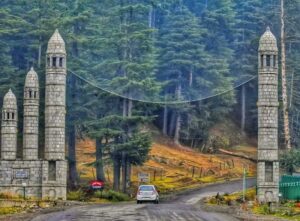Imagine a garden where every element — from the rustling Chinar leaves to the gurgle of fountains — was designed not just for beauty, but to mirror the very idea of paradise. Welcome to the Mughal Gardens of Srinagar, a spectacular fusion of art, nature, and imperial history that we Kashmiris have treasured for centuries.
Inspired by the ancient Persian concept of Charbagh (fourfold gardens representing the four rivers of paradise in the Quran), the Mughal emperors reimagined these heavenly landscapes in the breathtaking Kashmir Valley. With the glistening Dal Lake as their backdrop and the Zabarwan hills embracing them, these gardens became symbols of imperial love, poetry, and spiritual reflection.
Today, four remarkable gardens — Nishat Bagh, Shalimar Bagh, Chashme Shahi, and often-included Pari Mahal — remain Srinagar’s crown jewels, offering travelers a serene escape into our region’s regal past.
As someone who has spent a lifetime wandering these historic pathways, I bring you this definitive 2025 guide to Mughal Gardens Srinagar — covering their history, design principles, timings, entry fees, and visiting tips that only a local could share. Let’s begin!
Understanding Mughal Gardens Srinagar Design Principles
To truly appreciate these gardens as we Kashmiris do, you need to understand what made them so extraordinary in their time — and why they still captivate visitors today.
The Charbagh Concept
At the core of Mughal landscaping lies the Charbagh layout — a rectangular or square garden divided into four quadrants by water channels and walkways. Inspired by Quranic descriptions of paradise, these gardens symbolized abundance, order, and spiritual tranquility.
Key aspects of the Charbagh layout in Mughal Gardens Srinagar:
- Central water channels representing the rivers of paradise.
- Raised pathways dividing the space into four equal parts.
- A central pool or pavilion often marking the focal point.
Key Elements of Mughal Gardens
What makes Srinagar’s Mughal gardens so unique is how they adapted these Persian ideals to our Kashmir’s topography and climate:
- Terraced Levels: Built into natural slopes, using multiple terraces to enhance views and create distinct spaces.
- Water Channels & Fountains: Channels, pools, and cascading fountains added motion, sound, and reflection — vital elements of Mughal aesthetics.
- Pavilions (Baradaris): Elegant structures for leisure, poetry recitals, and royal gatherings, offering shaded spots for relaxation.
- Chinar Trees: These towering native trees provided shade, seasonal color, and elegance — especially in autumn when their leaves blaze red and gold.
- Vistas & Framed Views: Every garden was designed with carefully framed views of Dal Lake or the snow-capped mountains, crafting living paintings from nature.
Exploring Mughal Gardens Srinagar: The Four Crown Jewels
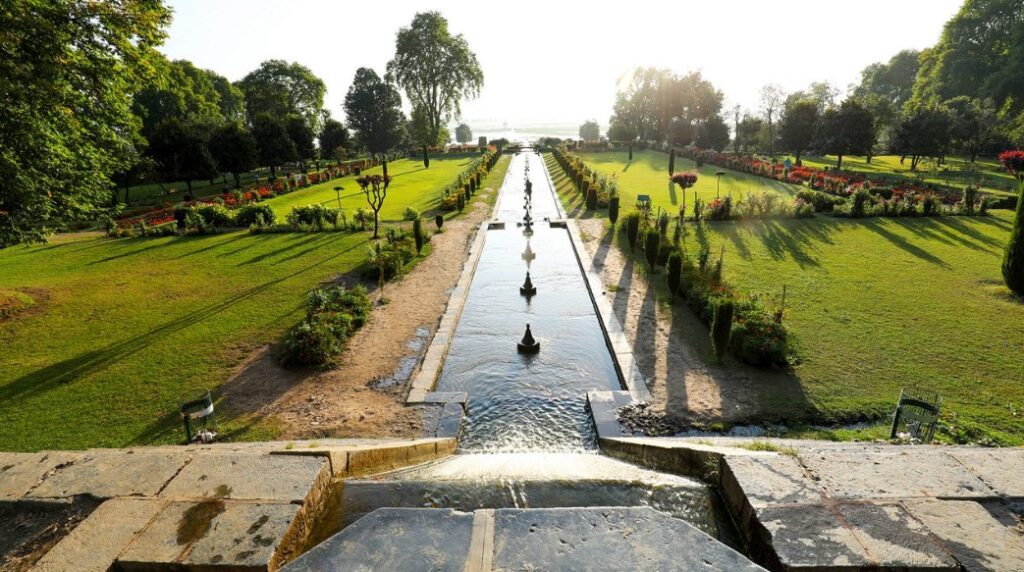
Each garden has its own story, architectural quirks, and sensory pleasures. Here’s your in-depth guide from someone who has witnessed these gardens in all seasons:
Nishat Bagh (‘Garden of Joy’)
History: Built in 1633 by Asif Khan, brother of the famed Nur Jahan, Nishat Bagh is the largest and arguably the most striking of Mughal Gardens Srinagar.
Layout & Features:
- 12 terraced levels climbing up from Dal Lake (symbolizing the 12 zodiac signs).
- A central water channel, aligned perfectly from the entrance to the topmost terrace, adorned with fountains and lined by flowerbeds.
- Towering Chinar trees create dappled shade and a dramatic backdrop, especially in autumn.
- Best Photo Spot: The view from the highest terrace, looking down the water channel towards Dal Lake, framed by ancient trees and misty mountains — a sight you won’t forget.
Local Experience: As Kashmiris, we frequent Nishat Bagh for morning walks and family picnics. Early in the day, you’ll find locals practicing yoga and meditation under the ancient Chinars. On weekends, elderly Kashmiris gather to play traditional board games like “Chaupat” in the shade, while exchanging stories of old Srinagar.
For Tourists: Join the locals for an early morning walk and bring a small picnic to enjoy on the lawns. For a truly authentic experience, arrive around 9:30 AM and ask any of the garden caretakers (usually friendly elderly men) about the best spots for photography — they’ll happily share stories about the garden’s history not found in guidebooks. In spring, participate in informal flower-spotting walks that happen spontaneously among visitors.
Experience Point: “The view from the topmost terrace of Nishat Bagh, gazing down the cascading water channel towards the glittering expanse of Dal Lake, is simply breathtaking. Having spent countless mornings here watching the light change, I can tell you it’s like peering into a perfectly composed Mughal painting come to life.”
Shalimar Bagh (‘Abode of Love’)
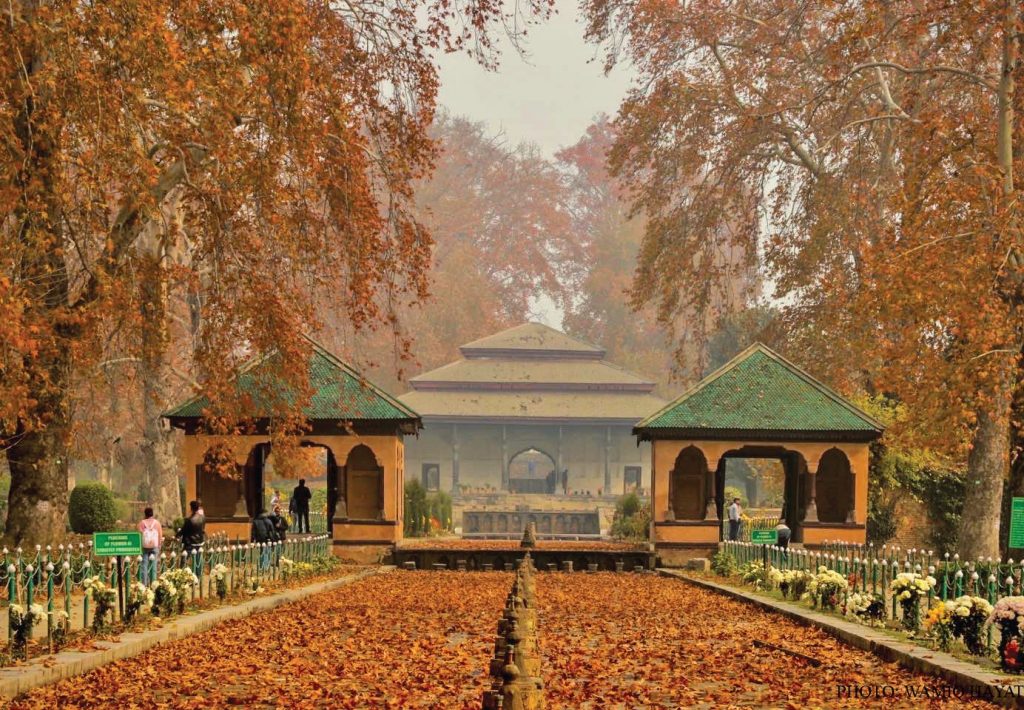
History: Commissioned in 1619 by Emperor Jahangir for his beloved queen Nur Jahan, Shalimar Bagh was conceived as an imperial pleasure garden and a symbol of undying love.
Layout & Features:
- Divided into three main terraces, each with a unique function:
- Diwan-e-Aam — the public garden.
- Diwan-e-Khas — for royal guests.
- Zenana Garden — reserved for the royal women.
- The black marble pavilion in the Zenana terrace is its most iconic feature.
- Chini Khanas: Arched niches behind the cascading waterfalls, originally illuminated by oil lamps at night, adding a fairytale-like glow.
Local Experience: Shalimar Bagh holds special significance for us Kashmiris, particularly as a venue for cultural celebrations. During the annual Shalimar Festival (typically held in May), local artists perform traditional Kashmiri music and dance. Throughout summer evenings, you’ll find local poets hosting informal gatherings reciting verse in Kashmiri and Urdu, continuing a tradition that dates back to the Mughal era.
For Tourists: Time your visit to coincide with the evening fountain display (4:00-5:00 PM in summer months) when all water features run simultaneously — a spectacle we locals never tire of. Engage with the gardeners who often demonstrate traditional pruning techniques passed down through generations. If you’re interested in Kashmiri poetry, ask around for information about evening poetry gatherings that welcome respectful visitors.
Expertise Detail: In Mughal times, access to these terraces was highly restricted. The Diwan-e-Khas could only be accessed by the emperor’s trusted courtiers, while the Zenana Garden remained a secluded sanctuary for women of the royal household. Today, as a custodian of these gardens, I feel privileged that all visitors can access areas once reserved for royalty.
Chashme Shahi (‘Royal Spring’)
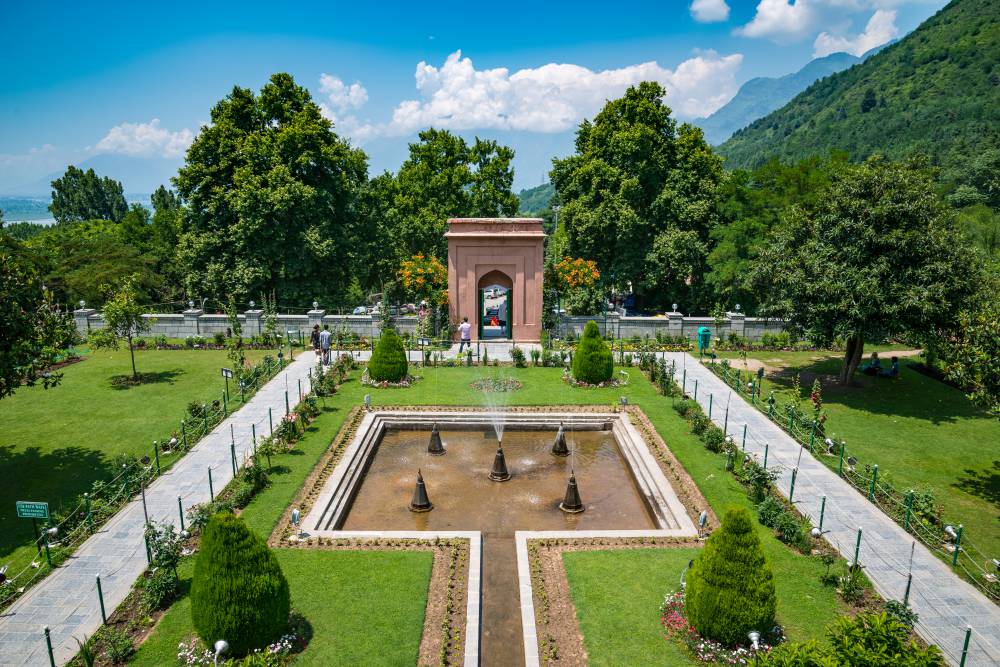
History: This charming, smaller garden was built by Shah Jahan in 1632 around a natural freshwater spring believed to have healing properties.
Layout & Features:
- Three terraced levels, connected by flowing water channels.
- The famous spring pavilion, where you can still sip the cool, crystal-clear water.
- Terraced flower beds and neatly manicured lawns.
- Good Views: Thanks to its hillside perch, the garden offers fine vistas over Dal Lake and Srinagar city.
Local Experience: Chashme Shahi holds special importance for Kashmiris seeking the spring’s healing waters. Many locals, myself included, make regular trips here with small copper vessels (known as “tamba”) to collect water believed to aid digestion and improve health. Early mornings see elderly Kashmiris performing their daily exercise routines along the garden paths.
For Tourists: Bring an empty water bottle to taste the spring water — a tradition no visitor should miss. The best time is early morning (before 10 AM) when locals come for their daily water collection, creating a wonderful opportunity for cultural exchange. Join the informal “water tasting ceremony” where caretakers explain the spring’s mineral properties and historical significance. Photography enthusiasts can participate in impromptu dawn photography sessions that local hobbyists often organize.
Pari Mahal (‘The Fairies’ Abode’)
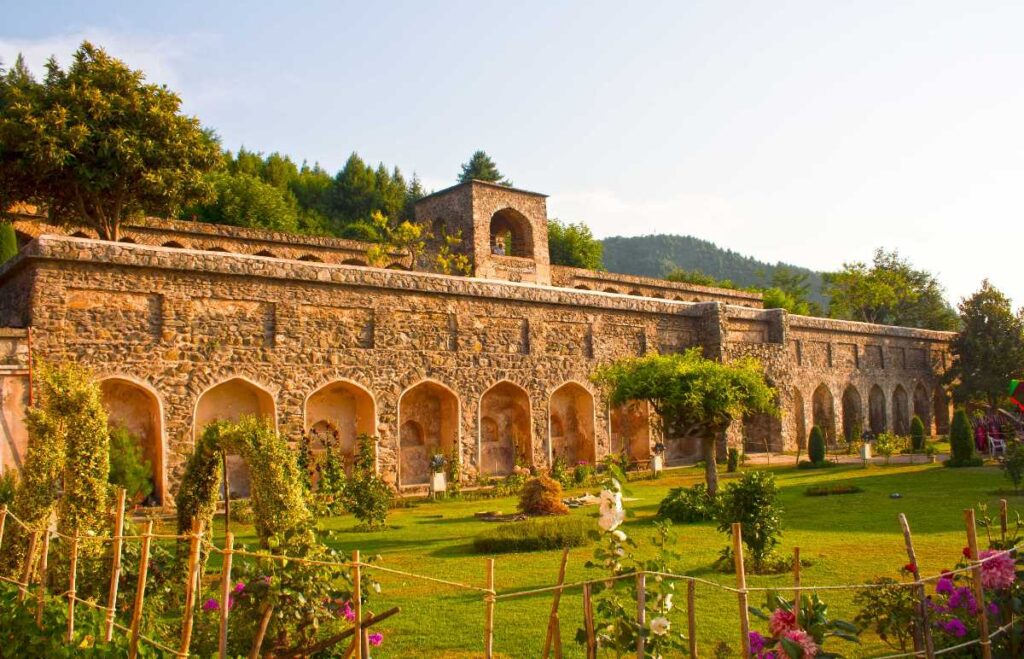
History: Constructed by Prince Dara Shikoh, Shah Jahan’s eldest son, Pari Mahal was never intended as a pleasure garden. It likely served as an observatory and a Sufi learning center, reflecting Dara’s mystical leanings.
Layout & Features:
- Seven expansive terraces built into the mountainside.
- Distinctive arched structures and long colonnades.
- Sunset Spot: Unparalleled panoramic views of Dal Lake, Srinagar city, and the Zabarwan mountains — especially enchanting at sunset.
Local Experience: For us Kashmiris, Pari Mahal represents a spiritual connection to our Sufi heritage. Local astronomy enthusiasts gather here during celestial events, continuing the tradition of stargazing established centuries ago. The garden is also a favorite spot for Kashmiri artists who come to sketch the panoramic views and historic architecture.
For Tourists: Plan your visit for sunset when local musicians occasionally perform traditional Kashmiri folk songs. Bring a sketchbook or journal — sitting in quiet contemplation here connects you to centuries of scholars who once studied under the same skies. Photography workshops run by local professionals often meet here during golden hour (just before sunset) and welcome visitors to join.
Visual Note: Each garden offers striking scenes worth capturing: terraced flowerbeds, ancient pavilions, gurgling fountains, and the fiery autumn Chinars. Don’t forget your camera!
Practical Information for Visiting Mughal Gardens Srinagar [2025 Update]
Locations: All four gardens cluster around Dal Lake and the Zabarwan foothills.
Suggested Visiting Sequence: As a lifelong resident, I recommend starting from Shalimar Bagh (furthest out), then visit Nishat Bagh, move to Chashme Shahi, and finally end at Pari Mahal for sunset. Alternatively, reverse it if chasing morning light. This route minimizes travel time and additionally follows the natural progression of garden styles.
Timings: As of April 11, 2025: 9:00 AM – 6:00 PM daily. Note: Timings may vary slightly by season or on Fridays — verify locally.
Entry Fees (Approximate as of April 11, 2025):
- Nishat Bagh: ₹40 per person
- Shalimar Bagh: ₹40 per person
- Chashme Shahi: ₹30 per person
- Pari Mahal: ₹30 per person Separate tickets for each garden. Fees subject to change. Therefore, check J&K Department of Floriculture for updates.
Best Time to Visit:
- Spring (April–May): Tulips in bloom, fresh flowers, pleasant weather. This is when we locals most frequently visit.
- Summer (June–August): Lush greenery, active fountains, and perfect for evening visits.
- Autumn (September–October): Stunning Chinar foliage in fiery reds and golds – my personal favorite season.
Insider Tip: Visit in the early morning for soft light, tranquil paths, and consequently, the sound of fountains uninterrupted by crowds. This is when most Kashmiris visit, thereby offering the most authentic experience.
Time Required:
- Nishat & Shalimar Bagh: 1.5–2 hours each
- Chashme Shahi & Pari Mahal: 1 hour each Additionally, factor in 10–20 minutes of travel between gardens.
Facilities:
- Public restrooms at all gardens.
- Light refreshments and local snack stalls near gates (try the Kashmiri kahwa tea and nadru monji (lotus stem fritters) for a truly local experience).
- Note: Terraces involve steps — moderate accessibility.
Local Transportation Tips: Auto-rickshaws and taxis are readily available, however, for a truly local experience, consider hiring a traditional shikara boat to visit the gardens accessible from Dal Lake (particularly Nishat and Shalimar). As a Kashmiri, I therefore recommend negotiating rates beforehand and subsequently asking your hotel to arrange a reliable driver for the day.
Seasonal Experiences at Mughal Gardens Srinagar
Each season transforms the Mughal Gardens Srinagar into a different experience altogether. Here’s what you can expect throughout the year:
Spring (April-May): The gardens burst with thousands of tulips, daffodils, and narcissi. Local families flock here for picnics under blooming cherry and almond trees. Consequently, join informal flower walks led by garden enthusiasts and furthermore participate in the local tradition of taking family portraits among the blossoms.
Summer (June-August): This is when the water features truly come alive. The fountains run at full capacity, thus creating a cooling atmosphere even on warmer days. We Kashmiris often visit in the evenings to escape the heat. Meanwhile, join locals for sunset chai sessions near the outer lawns of Nishat Bagh.
Autumn (September-October): The Chinar trees transform into a canvas of red, orange, and gold. Photography clubs organize fall foliage walks, and as a result, the gardens become galleries of natural art. This is, therefore, the perfect time to participate in leaf-collecting walks with local children who create pressed-leaf souvenirs.
Winter (November-March): Though fountains are turned off, nevertheless, the gardens take on a serene, contemplative beauty. On sunny winter days, local elders gather for noon chai and discussions. The fewer visitors mean, moreover, more personal interactions with caretakers who have fascinating stories to share.
Cultural Events at Mughal Gardens Srinagar Throughout the Year
In addition to their natural beauty, the Mughal Gardens Srinagar also serve as venues for various cultural events that both locals and tourists can enjoy:
Spring Flower Festival (April): Held primarily at Nishat Bagh, this festival celebrates the blooming season with flower exhibitions, traditional music performances, and furthermore, handicraft demonstrations. Visitors can, therefore, learn about Kashmir’s horticultural traditions firsthand from local experts.
Summer Music Evenings (June-August): Particularly at Shalimar Bagh, the longer summer evenings bring occasional Sufi music performances. Meanwhile, local musicians playing the santoor and rabab create a magical atmosphere as the sun sets behind the mountains.
Autumn Heritage Walks (September-October): During this season, cultural organizations conduct heritage walks through the gardens, focusing not only on their history but also on the architectural innovations and botanical significance. Additionally, traditional storytellers share tales of the Mughal era and their connection to these majestic spaces.
Winter Photography Exhibitions (December-January): Though less frequented in winter, the gardens occasionally host photography exhibitions showcasing images of the gardens through different seasons. Local photographers, consequently, share their techniques for capturing the essence of these historic spaces in varying light conditions.
Experiencing the Magic of Mughal Gardens Srinagar
The Mughal Gardens Srinagar are more than scenic retreats, they are living testaments to centuries of imperial art, poetry, and horticultural mastery that we Kashmiris have preserved with pride. Whether it’s the majestic terraces of Nishat Bagh, the romantic history of Shalimar, the refreshing spring of Chashme Shahi, or alternatively, the mystical sunset views from Pari Mahal, each offers a distinct, unforgettable experience.
As someone who has grown up in the shadow of these magnificent gardens, I therefore invite you to experience them not just as a tourist attraction, but rather as living cultural landmarks where our community continues to gather, celebrate, and find peace. For anyone seeking the soul of Kashmir — serene, regal, and breathtakingly beautiful, these gardens remain, without a doubt, essential stops on any Srinagar itinerary.
Finally, remember that the true beauty of Mughal Gardens Srinagar lies not only in their design and history but also in how they continue to serve as spaces of community gathering, artistic inspiration, and cultural preservation. By visiting mindfully and engaging with locals, you’ll consequently gain a much deeper appreciation of these remarkable gardens that have stood the test of time.
